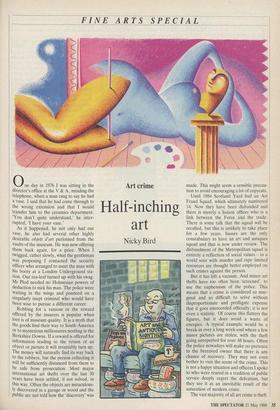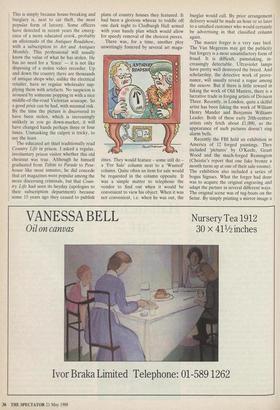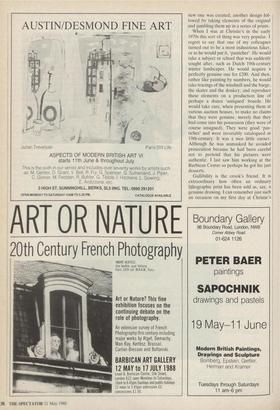FINE ARTS SPECIAL
0 ne day in 1976 I was sitting in the director's office at the V & A, minding the telephone, when a man rang to say he had a vase. I said that he had come through to the wrong extension and that I would transfer him to the ceramics department. `You don't quite understand,' he inter- rupted, 'I have your vase.'
As it happened, he not only had our vase, he also had several other highly desirable objets d'art purloined from the vaults of the museum. He was now offering Robbing for a ransom or the reward offered by the insurers is popular when loot is of museum quality. It is a myth that the goods find their way to South America or to mysterious millionaires nestling in the Berkshire Downs. If a reward is offered for information leading to the return of an object or picture it will invariably turn up. The money will naturally find its way back to the robbers, but the person collecting it will be sufficiently distanced from them to be safe from prosecution. Most major international art thefts over the last 30 years have been settled, if not solved, in this way. Often the objects are miraculous- ly discovered in a garage or wood and the public are not told how the 'discovery' was
Art crime
Half-inching art
Nicky Bird
made. This might seem a sensible precau- tion to avoid encouraging a lot of copycats.
Until 1984 Scotland Yard had an Art Fraud Squad, which ultimately numbered 14. Now they have been disbanded and there is merely a liaison officer who is a link between the Force and the trade. There is some talk that the squad will be recalled, but this is unlikely to take place for a few years. Sussex are the only constabulary to have an art and antiques squad and that is now under review. The disbandment of the Metropolitan squad is entirely a reflection of social values — in a world sour with murder and rape limited resources are thought better employed on such crimes against the person.
But it has left a vacuum. And minor art thefts have too often been 'screened', to use the euphemism of the police. This means that a crime is considered so mar- ginal and so difficult to solve without disproportionate and profligate expense that it goes unrecorded officially; it is not even a statistic. Of course this flatters the figures, but it does avoid a waste of energies. A typical example would be a break-in over a long week-end where a few minor pictures are stolen, with the theft going unreported for over 48 hours. Often the police nowadays will make no pretence to the bereaved owner that there is any chance of recovery. They may not even bother to visit the scene of the crime. This is not a happy situation and officers I spoke to who were reared in a tradition of public service deeply regret the defeatism, but they see it as an inevitable result of the saturation of modern crime.
The vast majority of all art crime is theft. This is simply because house-breaking and burglary is, next to car theft, the most popular form of larceny. Some officers have detected in recent years the emerg- ence of a more educated crook, probably an aficionado of the Antiques Roadshow, with a subscription to Art and Antiques Monthly. This professional will usually know the value of what he has stolen. He has no need for a 'fence' — it is not like disposing of a stolen video recorder. Up and down the country there are thousands of antique shops who, unlike the electrical retailer, have no regular wholesaler sup- plying them with artefacts. No suspicion is aroused by someone popping in with a nice middle-of-the-road Victorian seascape. So a good price can be had, with minimal risk. By the time the picture is discovered to have been stolen, which is increasingly unlikely as you go down-market, it will have changed hands perhaps three or four times. Unmasking the culprit is tricky, to say the least.
The educated art thief traditionally read Country Life in prison. I asked a regular, involuntary prison visitor whether this old chestnut was true. Although he himself graduated from Titbits to Parade to Pent- house like most inmates, he did concede that art magazines were popular among the more discerning criminals, but that Coun- try Life had seen its heyday (apologies to their subscription department) because some 15 years ago they ceased to publish
plans of country houses they featured. It had been a glorious wheeze to toddle off one dark night to Clodburgh Hall armed with your handy plan which would allow for speedy removal of the choicest pieces.
There was, for a time, another ploy unwittingly fostered by several art maga- zines. They would feature – some still do a 'For Sale' column next to a 'Wanted' column. Quite often an item for sale would be requested in the column opposite. It was a simple matter to telephone the vendor to find out when it would be convenient to view his object. When it was not convenient, i.e. when he was out, the burglar would call. By prior arrangement delivery would be made an hour or so later to a satisfied customer who would certainly be advertising in that classified column again.
The master forger is a very rare bird. The Van Megerens may get the publicity but forgery is a most unsatisfactory form of fraud. It is difficult, painstaking, in- creasingly detectable. Ultraviolet lamps have pretty well destroyed the breed. And scholarship, the detective work of prove- nance, will usually reveal a rogue among the oeuvre. But if there is little reward in faking the work of Old Masters, there is a lucrative trade in forging artists of Division Three. Recently, in London, quite a skilful artist has been faking the work of William Henry Mander and Benjamin Williams Leader. Both of these early 20th-century artists only fetch about £1,000, so the appearance of such pictures doesn't ring alarm bells.
Recently the FBI held an exhibition in America of 12 forged paintings. They included 'pictures' by O'Keefe, Grant Wood and the much-forged Remington (Christie's report that one fake bronze a month turns up at one of their sale-rooms). The exhibition also included a series of bogus Signacs. What the forger had done was to acquire the original engraving and adapt the picture in several different ways. The original scene was of tug-boats on the Seine. By simply printing a mirror image a new one was created; another design fol- lowed by taking elements of the original and jumbling them up in a series of prints.
When I was at Christie's in the early 1970s this sort of thing was very popular. I regret to say that one of my colleagues turned out to be a most industrious faker, or as he would put it, 'pastiche. He would take a subject or school that was suddenly sought after, such as Dutch 19th-century winter landscapes. He would acquire a perfectly genuine one for £200. And then, rather like painting by numbers, he would take tracings of the windmill and the barge, the skater and the donkey, and reproduce these elements on a production line of perhaps a dozen 'antiqued' boards. He would take care, when presenting them at various auction houses, to make no claims that they were genuine, merely that they had come into his p6ssession (they were of course unsigned). They were good 'pas- tiches' and were invariably catalogued as 19th-century. It was a nice little earner. Although he was unmasked he avoided prosecution because he had been careful not to pretend that his pictures were authentic. I last saw him working at the Barbican Centre so perhaps he got his just desserts.
Gullibility is the crook's friend. It is extraordinary how often an ordinary lithographic print has been sold as, say, a genuine drawing. I can remember just such an occasion on my first day at Christie's
when a couple of Samuel Palmer drawings, supposedly, were brought in. I took them down the corridor to the crusty expert. `They're prints, aren't they?' he growled.
'How can you tell?' I asked.
'Rub a bit out,' the sage responded. He gave me a rubber. I rubbed the first picture. Nothing disappeared. It was a print. I rubbed the second. Half the signature disappeared. It was a drawing.
I returned to the front counter. I told the owner that one of his pictures was nothing more than a reproduction. And the other, he enquired? 'A drawing by a man named —almer,' I joked. He looked at it. He was not amused. Luckily, the thing turned out to be phony.
Mich of the art trade subscribes to International Fine Art Reports, an Amer- ican monthly that details art frauds and stolen objects. It also has a computer archive of stolen goods which can prove
invaluable. The magazine itself makes Instructive reading. Watch out, they say, for a `Dali' called 'Columbus Discovering America' which comes complete with an Impressive certificate of authenticity. It is supposedly a signed engraving. It is no- thing of the kind. It is, like my Palmer, a simple lithographic reproduction of an existing painting. Pennsylvania impression- ists have become popular and Edward Willis Redfield has recently been faked. There is the loony megalomaniac collector Doctor Frank Waxman who ordered 50 burglaries and 170 works of art for his delectation. And there is the story of Operation Carpetbagger in Toronto a cou- ple of years ago: a man called Henri Kuntz organised the theft of various works of art from Canadian galleries and sent the pro- ceeds to a painter in Toulouse called Jean Jaures, who produced lots of lovely copies. These were imported by M. Kuntz's com- pany, Art Diffusion. These variations on the original works of art were often sold back to the very gallery where the inspira- tion had come from. Kuntz had a boggling number of aliases, but he was known universally as, you guessed it, Frenchie. One of the neatest enterprises has taken place in Britain. Recently a lot of fake Clarys Cliffe pottery found its way on to the market. Some clever legwork revealed the source — Featherstone Prison in Wol- verhampton. A prisoner, wishing to better himself, had joined the rehabilitation class in pottery. His teacher showed him pic- tures of Cliffe's work which he began to produce quite skilfully. Every visiting day, he would give his missus a couple of pots to take away. His industry was impressive, the trickle became a stream, no one realised why. I hope when he gets out he goes straight and joins the Crafts Council.

































































 Previous page
Previous page